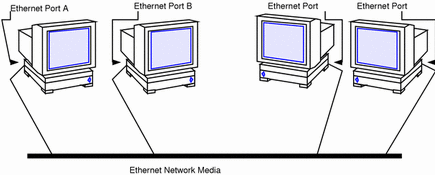Types of Hardware That Make Up a Solaris Network
The term local-area network (LAN) refers to a single network of computers limited to a moderate geographical range, such as the floor of a building or two adjacent buildings. A local-area network has both hardware and software components. From a hardware perspective, a basic Solaris LAN consists of two or more computers attached to some form of local-area network media.
Local-Area Network Media
The cabling or wiring used for computer networks is referred to as network media. Figure 1-1 shows four computers connected by means of Ethernet media. In the Solaris LAN environment, Ethernet is the most commonly used local-area network media. Other types of local-area network media used in a Solaris LAN might include FDDI or Token Ring.
Figure 1-1 A Solaris Local Area Network

Computers and Their Connectors
Computers on a TCP/IP network use two different kinds of connectors to connect to network media: serial ports, and the ports on the network interface.
Serial Ports
Each computer has at least two serial ports, the connectors that enable you to plug a printer or modem into the computer. The serial ports may be attached to the CPU board, or you may have to purchase them. You use these ports when attaching a modem to the system to establish a PPP or UUCP connection. PPP and UUCP actually provide wide-area network services, since they may use telephone lines as their network media.
Network Interfaces
The hardware in a computer that enables you to connect it to a network is known as a network interface. Many computers come with a preinstalled network interface; others may require you to purchase the network interface separately.
Each LAN media type has its own associated network interface. For example, if you want to use Ethernet as your network media, you must have an Ethernet interface installed in each host to be part of the network. The connectors on the board to which you attach the Ethernet cable are referred to as Ethernet ports. If you plan to use FDDI, each prospective host must have an FDDI network interface, and so on.
This book refers to the default network interface on a host as the primary network interface.
Note -
Installing network hardware is outside the scope of this guide. Refer to System Administration Guide for instructions for configuring serial ports and manuals accompanying network media for installation instructions.
- © 2010, Oracle Corporation and/or its affiliates
